How environmentally friendly are Iceland’s data centers? – Part 2
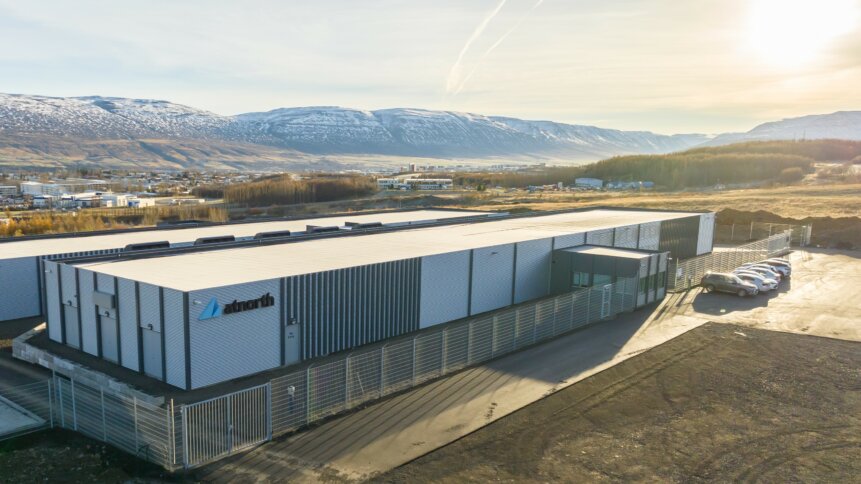
- Iceland leads in renewable energy and innovates in carbon reduction.
- Experts say companies need to station their data near green energy.
- Subsea cables reduce latency and cause little environmental disruption.
Part 2: Energy and cables
Iceland is ecologically blessed in many ways: gentle-sloping mountains, arctic foxes, geothermally-heated lagoons, and an abundance of renewable energy to harness. With a population of less than 400,000 people, there is more than enough power to go around, helping Iceland to frequently rank in the top ten most environmentally friendly countries in the world.
While the majority of the energy comes from controllable hydropower – the numerous rivers and reservoirs formed from a glacial and volcanic landscape allow for an abundance of free-flowing water – geothermal energy covers 90 percent of space heating in Iceland. The 464°F to 626°F (240°C to 330°C) steam produced by boreholes first powers electricity turbines, and there is so much potential that the Hellisheiði power plant, run by the largest geothermal energy company in Iceland, ON Power, is surrounded by a cloud of excess vapor. Once passed through the turbine, it is condensed to water at a temperature of about 356°F (180°C), and its heat is used to warm up fresh water that is then piped to homes around the country.
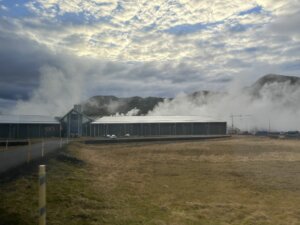
Boreholes in Iceland produce so much steam, the Hellisheiði geothermal power station is constantly surrounded by a cloud of excess vapor. Source: TechHQ
The secrets of Iceland’s renewable energy
Last year, OR Energy, ON Power’s parent company, produced 106 million m2 of hot water for district heating and 1,134 GWh of electricity for Icelandic consumption. Using 60 active boreholes with an average depth of about 2.5 km, Hellisheiði alone produces 303 MW of electricity with its seven turbines and almost 1,000 liters per second of hot water. About 11 percent of the hot water in the Reykjavík region is also pumped directly from wells in low-temperature fields which do not produce steam and, therefore, cannot be harnessed for electricity. This water also contains a high concentration of minerals and trace amounts of hydrogen sulfide, which can cause it to smell like rotten eggs.
But that is not all that comes out of the boreholes – in fact, 0.4 percent is carbon dioxide. While this only equates to about 7.6 g of carbon per kWh of energy production (compared to about 800 g for coal), those emissions are partly what inspired researchers at OR Energy to develop Carbfix. Carbfix is a relatively new carbon capture method involving carbon dioxide and hydrogen sulfide being dissolved in water before being injected into decommissioned boreholes at Hellisheiði.
The acidity of the liquid dissolves anything that has already settled in the porous underground basalt, and then the carbon dioxide reacts with this stone to form a calcite precipitate. The hydrogen sulfide simultaneously reacts with the iron in the basalt to form iron sulfide, and these two precipitates remain underground.
Thanks to this relatively recent innovation, 13,000 tonnes of mineralized carbon dioxide was stored underground last year rather than released into the atmosphere. Roughly 100 kg of carbon can be stored in a single cubic meter of basalt, meaning Iceland alone has enough rock to store 40 years’ worth of global emissions. The world is also covered in basalt, so there is plenty of scope for expansion, and researchers are currently looking into whether the gases can be dissolved in seawater rather than freshwater in the future. Landsvirkjun, the national power company of Iceland, intends to be carbon negative within two years and both of the ON Power plants will be carbon neutral by 2030.
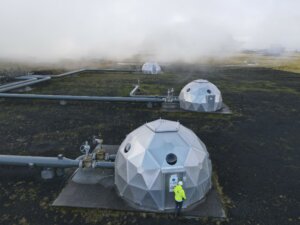
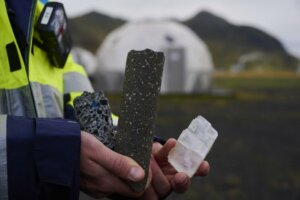
Top: Carbfix domes at the Hellisheidi power plant. Bottom: After the dissolved carbon dioxide is pumped underground, it reacts with the basalt (left) to form a calcite precipitate (right) in the pores. Source: AFP
Despite boasting impressive statistics, the energy industry in Iceland is not perfect. In April, the Association of Issuing Bodies (AIB) suspended Iceland from selling “guarantees of origin” renewable energy certificates. This is because it came to light that “double claiming of energy attributes was taking place”, meaning that the energy the certificates claimed to be selling elsewhere was actually being used by Icelandic companies. Iceland has an isolated electricity grid so doesn’t physically export any energy, but it sells the rights to claim that a certain amount used by a company was generated from renewable sources because it has been offset against Icelandic production.
Journalist Hanno Böck uncovered that Iceland’s smelters have a combined electricity consumption of about 12 TWh, and approximately 15 TWh of electricity is exported via certificates, but the country only produces about 19 TWh of electricity annually in total. The risk of double-counting was highlighted in 2016 in a report from the Icelandic government. The energy certificate suspension was lifted on June 1 despite no solution being found and, in November, AIB said that “Landsnet has complied with the requirements of the Rectification Order” which required it to report issues identified and the actions taken to remediate any non-compliance.
Data centers currently account for only about seven percent of Iceland’s energy usage, with the largest and most energy-intensive industry being aluminum smelting. But the fact that the country has been relatively successful with its renewable energy certainly does point towards a sustainable future for the companies that invest in the facilities.
READ NEXT
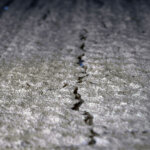
Technology to save the planet
Move data, not energy
Erik Gjesdal, Segment Manager C&SP at Schneider Electric, claims that ‘Scope 3’ emissions – indirect greenhouse gas emissions that occur from sources not owned or controlled by an organization but are associated with its activities, like those from data centers – are becoming the most significant ones for tech companies to address. At the Datacenter Forum, he said, “We’ve come to a point where arguably putting more energy into PUE (power usage effectiveness) is not getting the largest ROI in terms of sustainability.”
Halldór Már Sæmundsson, the CCO of Borealis data centers, added that “moving data, not energy” is the solution to environmental and cost efficiency. He said: “You need to place data centers as close to the source of green energy as possible, not transport the energy, not build unnecessary capacity for workloads that are not latency-sensitive in cities like London or Frankfurt, for example.” Indeed, very few people are happy to have a power line going through their backyard, but having a fiber running underground is trivial. Data can also easily be sent to other countries quickly and ready to use, making it a better vehicle for the global distribution of Iceland’s energy than certificates.
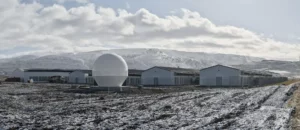
Halldór Már Sæmundsson, the CCO of Borealis data centers, said: said: “You need to place data centers as close to the source of green energy as possible, not transport the energy.” Source: Borealis
Neither geothermal energy nor hydropower produces radioactive waste like nuclear plants, and Landsvirkjun is investigating whether wind power could act as another renewable energy source on the famously blowy island. Energy in Iceland is cheaper than elsewhere, as renewable energy sources are domestically available and require minimal ongoing fuel extraction or importation expenses. As a result, according to E+T, it costs approximately 72 percent less to run data center operations in Iceland than in London. Icelandic data center companies atNorth and Borealis recently announced they are looking to reduce their power costs even further by utilizing the Snerpa Power platform to track and optimize their electricity consumption and participate actively in the balancing of supply and demand in the energy market.
Connecting Iceland to the world
At the Datacenter Forum, Þorvarður Sveinsson, the CEO of submarine cable company Farice, said: “I believe that global problems that we’re seeing in terms of sustainability require global solutions, and that requires communications. We need communications in order to take advantage of offerings that Iceland has to offer sustainable energy, cooler climate, everything that it takes.”
Iceland has four active submarine communications cables that connect its data centers overseas, and three of these are operated by Farice. The company was established in 2002 to build its first cable, FARICE-1, linking an Icelandic landing site to the Faroe Islands and Dunnet Bay in Scotland. Before then, Iceland relied on the outdated CANTAT-3 submarine cable and a basic satellite connection, but this was not nearly sufficient when internet usage by the general population started to grow.
The second fiber optic cable, DANICE, went live in 2009, connecting Iceland to Denmark, and the third cable, IRIS, came online on March 1 this year, connecting to Galway, Ireland. IRIS, which cost $55 million (€50 million) to build, reduced the latency between Iceland and London from 18.5 ms to 15 ms, and between Iceland and Dublin from 24 ms to 10.5 ms. The fourth cable, Greenland Connect, is operated by TELE Greenland and links Iceland to Greenland and Canada.
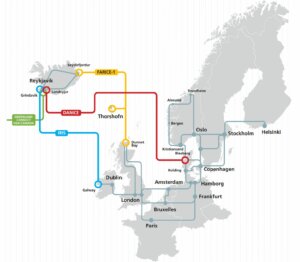
Submarine cable network of Iceland. Source: Farice
Iceland’s location between North America and Europe means it can attract major data center customers from both continents with high-speed, low-latency data connections. Iceland is expensive to connect to under the North Sea because there are many oil and gas pipes, so cables need more protection. “So for us to connect Iceland and Ireland is very natural, very intuitive, both because of distance and because of cost,” said Mr Sveinsson.
Businesses tend to be more concerned about data security than the environmental impact of their data centers and, with pictures of the bubbling ocean fresh in the public’s heads after the Nord Stream undersea gas pipeline explosion, submarine cables illicit the same question: what if they get cut?
“We never had to stop for any faults, which is quite unique actually for the submarine cables,” Mr Sveinsson told TechHQ. “But it’s so important that our cables are protected, for Iceland is an island 1,500 km in the North Atlantic open waters.” Any fault could take months to rectify, particularly if the weather is poor out at sea.
Iceland is very exposed to undersea threats by virtue of it being an island, but there is also the risk of tectonic activity in the form of earthquakes and volcanic eruptions. In November, the world was biting its nails as the Fagradalsfjall volcano threatened to erupt, causing the 4,000 residents of nearby Grindavik to evacuate. This event evoked memories of the series of eruptions of Eyjafjallajokull in 2010, which disrupted flights across Western Europe.
At the Datacenter Forum, Mr Sveinsson said: “We in the industry have been designing our network for decades in order to sustain all kinds of events, natural ones or man-made. We eliminate single points of failure. We take great care to design and build our networks in a more secure manner so if there is a fault, if there is a break, if there is a natural hazard or even a terrorism attack, then we have redundancies.”
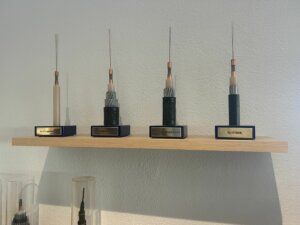
Farice cables through time. The company was established in 2002 to build its first cable, FARICE-1, linking an Icelandic landing site to the Faroe Islands and Dunnet Bay in Scotland. Source: TechHQ
The terrestrial network that connects the three cable landing sites in Iceland is based on three rings to create redundancies on land, and the addition of IRIS increased the theoretical availability of the network tenfold. “This is why we’ve built the third one, to increase diversity, develop new landing sites, new routes to make the existing network even more secure,” Mr Sveinsson told TechHQ. The network has been designed to reduce the risk of a single incident impacting more than one cable. If there is a cut, the traffic can always go along another route. “We basically make sure that [all data center customers] are using all three networks, all three cables, and distribute the traffic equally and have sufficient room for redundancy,” he added.
IRIS is considered critical infrastructure as it provides connectivity to the people of Iceland, and the €50 million ($55 million) it took to build was funded by the country’s government and EFTA Surveillance Authority. If the entire network were to go offline somehow, Iceland’s only connection to the rest of the world would be via satellite, and therefore very slow. As Iceland does not own any satellites, this would involve an expensive rental, and even then, any bandwidth would likely be limited to government communications.
The fact that the Farice network is critical infrastructure means that data center customers are essentially taking advantage of the assurance such a title brings. “It’s so important for us that we take every precaution we possibly can to protect the network,” Mr Sveinsson told TechHQ. At the same time, Farice is still a commercial business, so it needs more customers to support the cost of maintaining the infrastructure.
At the Datacenter Forum, Borealis CEO Björn Brynjúlfsson said that, rather than being concerned about Iceland’s data security, businesses should think about their own. It used to be common for companies to want all their workloads in the same data center, backed by multiple diesel generators. However, having data geographically distributed across various locations can significantly enhance a company’s resilience against potential security threats or localized disruptions. “I think this is where Iceland can play a key role,” he said. “We are an island; we are relatively far from other areas, so storing your backups, or third sets of backups, in Iceland is a very viable thing to do.”
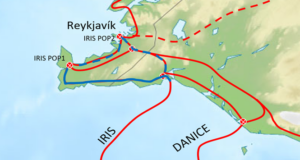
The terrestrial network that connects the three cable landing sites in Iceland is based on three rings to create redundancies on land. Source: Farice
The addition of IRIS to the Farice network did decrease the latency from Iceland to Ireland significantly, thanks to both the new direct connection between the two countries and the fact that the new cable is three times more efficient. “We have more fiber pairs, but also just the development of technology allows us to push more data through,” Mr Sveinsson told TechHQ. Such extreme technological advancements in just the last decade suggest that, at some point, the older cables currently on the seabed will become obsolete. The capacity of twenty-year-old FARICE-1 is 10 Tb/s, DANICE is 44 Tb/s, and IRIS is 145 Tb/s. However, Farice has no plans to remove any of its cables.
Mr Sveinsson said: “It’s not obvious to me that it makes sense from an economic or environmental view because when you rip the cable out of the seabed, you are disturbing it. But it is not obvious, there is some economic argument for actually taking up the entire cable and reusing the copper. This will become an issue or a question that we need to answer after maybe ten years.”
He added that his company will have a defined replacement system in place in the future, as the cable amplifiers are only built to last a decade. However, at the moment, Farice would opt to simply lay a new cable next to the obsolete one rather than replace it. Instead of allowing these new cables to spider out of Iceland in random directions, Mr Sveinsson says he expects “cable corridors” will be formed that will each connect to one landing station.
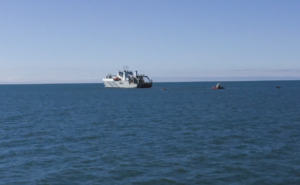
The addition of IRIS to the Farice network did decrease the latency from Iceland to Ireland significantly, thanks to both the new direct connection between the two countries and the fact that the new cable is three times more efficient. Pictured: Vessel laying the IRIS submarine cable. Source: Farice
He told TechHQ: “We need a sufficient number of cable landing sites and a decent number of diverse paths to Iceland to allow for security and redundancy. Then you can increase the capacity by laying more cables in those corridors. This is how it has been done in other countries that are much bigger than Iceland.”
These corridors will likely be chosen with deep sea fishing routes in mind, as certain types of fishing are not allowed where cables are laid around Iceland to avoid potential collisions. At ocean depths of over 1,500 m, the cable rests on top of the sea bed, but at shallower depths, it is plowed 1.5 meters down. It naturally becomes covered over time, so, after making the five-meter wide cut with 11 tonnes of power, the cable is “not really invasive to the environment,” according to Mr Sveinsson. Even before that, when Farice is planning a route, a seabed study is conducted involving SONAR scanning so it can avoid submarine boulders. During that study, as well as the cable installation process, a Marine Mammal Observer (MMO) is onboard. “There’s a staff member on the survey vessel with the only purpose of protecting mammal life,” Mr Sveinsson told TechHQ.
Read ‘Part 1: Demanding conditions’ here.
Read ‘Part 3: Data centers’ here.










